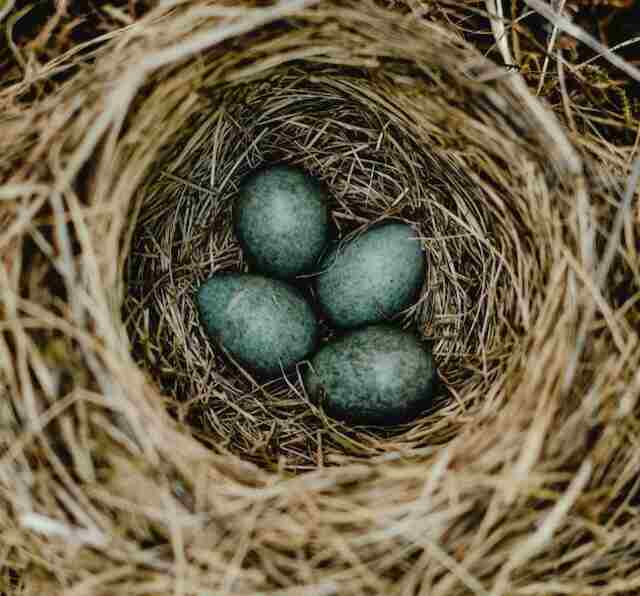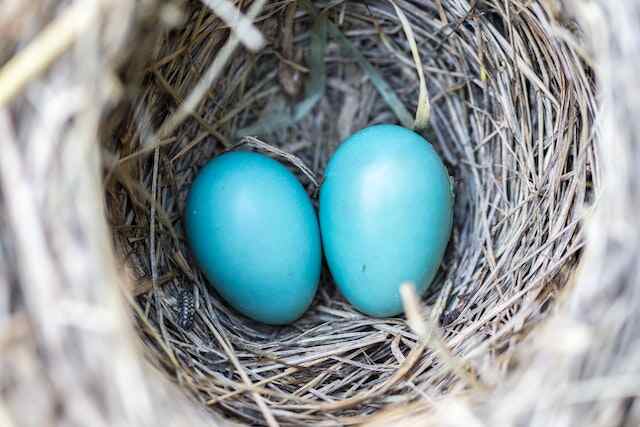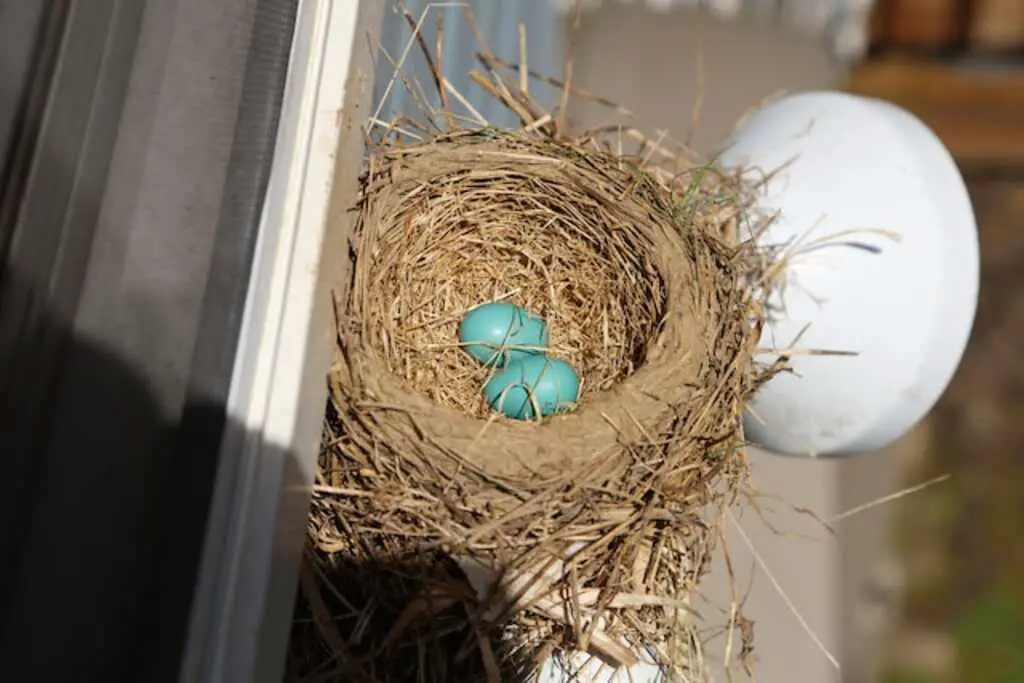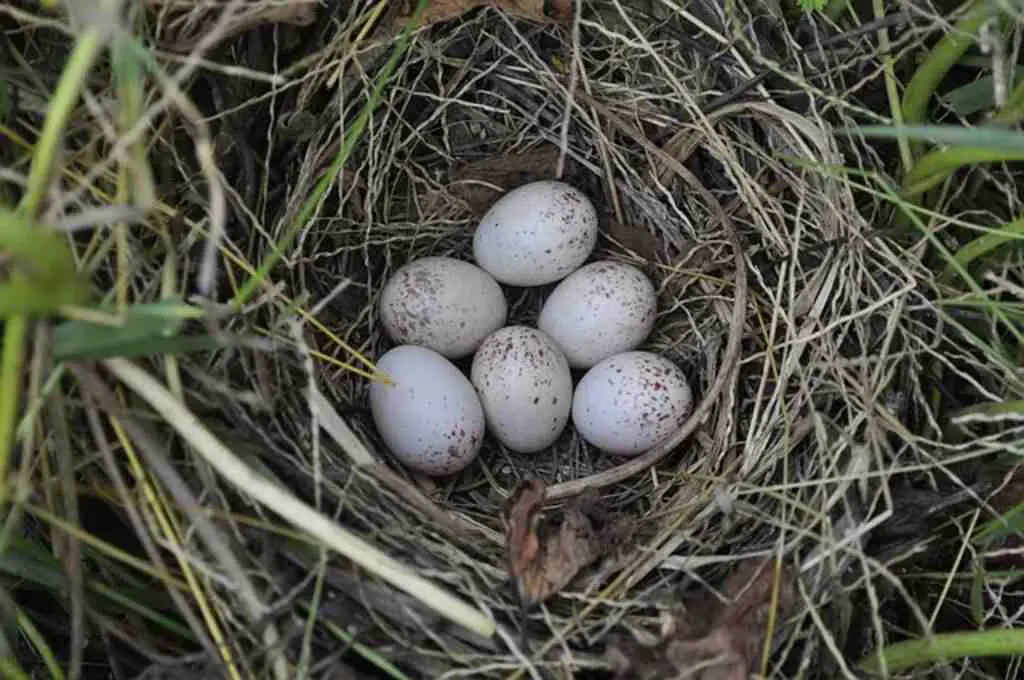Birds are some of the most fascinating creatures on the planet. They exhibit a wide range of behaviors and habits that have captivated the human imagination for centuries.
One of the most remarkable aspects of avian biology is their reproductive cycle, which involves a complex set of behaviors and interactions between male and female birds.
Understanding the timing of bird egg laying is an important aspect of studying bird biology, and can provide valuable insights into the conservation of bird populations.
Table of Contents
- 1 Key Takeaways:
- 2 What Season Do Birds Lay Eggs?
- 3 Understanding the Avian Reproductive Cycle
- 4 Nesting Habits and Behaviors
- 5 Egg Formation and Development
- 6 Incubation and Parental Care
- 7 Timing of Bird Egg Laying
- 8 Environmental and Geographic Influences
- 9 Examples from Different Bird Species
- 10 Conservation and Protection of Nesting Areas
- 11 Human Interactions and Nesting Disturbance
- 12 Conclusion
- 13 FAQs: What Season Do Birds Lay Eggs?
- 13.1 What season do birds lay eggs?
- 13.2 What are the different phases of the avian reproductive cycle?
- 13.3 How do birds select nesting sites?
- 13.4 How are bird eggs formed?
- 13.5 What is the role of incubation in bird reproduction?
- 13.6 When do birds breed and lay eggs?
- 13.7 How do environmental factors influence bird egg laying?
- 13.8 Can you provide examples of bird species and their egg-laying patterns?
- 13.9 Why is it important to protect nesting areas for birds?
- 13.10 What are the potential impacts of human activities on nesting birds?
- 14 Author
Key Takeaways:
- Birds exhibit a wide range of behaviors and habits, including complex reproductive cycles
- Understanding the timing of bird egg laying is important for studying bird biology and conservation

What Season Do Birds Lay Eggs?
Most birds lay eggs in the spring, although the exact timing can vary depending on the species and geographic location. Spring is a time of increased food availability and longer daylight hours, which stimulates birds’ reproductive hormones and triggers the breeding season.
Some birds, such as bald eagles and great horned owls, may lay eggs as early as January or February, while others may wait until May or June.
The timing of egg-laying can also be influenced by factors such as weather conditions, food availability, and nesting site availability.
Understanding the Avian Reproductive Cycle
Birds follow a unique reproductive cycle that is closely tied to seasonal changes. Breeding season, also known as the avian reproductive cycle, is an annual event that typically occurs during the warmer months of the year. During this time, male birds engage in courtship behavior to attract a mate and establish territory, while female birds undergo hormonal changes that lead to egg production.
The reproductive cycle of birds can be broken down into a few distinct phases. The first is the pre-breeding period, which occurs before egg laying begins. During this time, male birds establish territories and attract potential mates through displays of courtship and physical prowess.
The next phase is the actual egg-laying period, which can vary depending on the species of bird. Some birds lay eggs in the spring, while others wait until the summer or fall. Female birds typically lay one or two eggs at a time, with larger birds laying larger eggs than smaller ones.
After the eggs are laid, the incubation period begins. This is when the eggs are warmed by the parent birds to encourage the embryos inside to develop. Incubation can take anywhere from a few days to several weeks, depending on the species of bird.
Once the eggs hatch, the final phase of the reproductive cycle begins: parental care. Both male and female birds play a role in protecting and nurturing their offspring, providing them with food, warmth, and protection from predators. The length of the parental care period varies depending on the species of bird and the environment in which it lives.
Nesting Habits and Behaviors
During the breeding season, birds exhibit a variety of nesting habits and behaviors that are influenced by both instinct and environmental factors. The process of selecting a nesting site and building a nest is crucial for the survival of the eggs and the offspring that hatch from them.
Selection of Nesting Sites
The location of a bird’s nest is critical to the survival of the eggs and the chicks that hatch from them. Birds typically choose their nesting sites based on a variety of factors, including the availability of food, the presence of predators, and the suitability of the environment.
Some birds, like penguins, build their nests on rocky cliffs or in underground burrows, while others, like swallows, build their nests on man-made structures like buildings or bridges.
Nest Building
Once a nesting site has been selected, birds begin the process of building a nest. The materials used for nest-building vary depending on the bird species and the availability of resources in the environment. Common materials include twigs, grasses, feathers, and mud. The construction of the nest can take days or even weeks to complete.
Territorial Behavior
During the breeding season, many birds exhibit territorial behavior, aggressively defending their chosen nesting site from other birds. This behavior is particularly common among songbirds, who often engage in fierce battles to protect their mate and their territory. Some bird species, like hawks and eagles, are solitary nesters and do not exhibit territorial behavior.

Egg Formation and Development
Once a female bird has mated, the process of egg formation begins. Inside the female’s body, a yolk is formed and surrounded by albumen, or egg white. A hard, protective shell is also formed around the egg. The amount of time it takes for an egg to fully develop and be ready for laying varies by species, but can take anywhere from a few days to several weeks.
Egg production is influenced by several factors, including the bird’s age, health, and nutrition. Young birds may not produce as many eggs, while older birds may produce fewer as they near the end of their reproductive cycle. Proper nutrition, particularly a diet high in calcium, is crucial for egg development and the formation of strong eggshells.
In some cases, environmental factors can also impact egg formation. High temperatures, for example, can cause a decrease in egg production, while cooler temperatures may stimulate increased egg-laying as birds prepare for the breeding season.
Egg-Laying Patterns
The timing and frequency of egg laying varies by species. Some birds, like ducks and geese, lay a large number of eggs at once and then incubate them. Others, such as raptors and some songbirds, lay one egg at a time, spaced out over several days or weeks.
In general, birds will lay eggs during the breeding season, which can vary by region and species. For example, many North American songbirds such as Robin’s breed in the spring and summer, while some species of penguins breed in the winter months.
Incubation and Parental Care
During the incubation period, both male and female birds take on different roles in protecting and nurturing the eggs. Female birds usually take on the primary responsibility of incubating the eggs, while male birds provide support by bringing food and defending the nest territory.
Incubation periods vary depending on the species of bird, with some eggs taking only a few days to hatch and others taking several weeks. While female birds are usually the primary incubators, there are some species, such as penguins, where males take on this role.
Parental Care
Once the eggs hatch, parental care continues as both male and female birds take on the responsibility of feeding and protecting their young. This can involve regurgitating food for their chicks, teaching them how to fly and hunt, and defending them from predators.
Parental care can continue for several weeks or even months, depending on the species of bird. Some species exhibit communal nesting, where multiple adults will care for the young, while others will only have one parent present.
Timing of Bird Egg Laying
The timing of bird egg laying varies among different species and can be influenced by a variety of factors, including geographic location, weather patterns, and food availability. Generally, birds lay their eggs during the spring and summer months, when the weather is warmer and food resources are more abundant.
Some bird species, such as robins and blue jays, typically begin laying their eggs in early spring, while others, like hummingbirds, may wait until mid-summer. Other bird species, such as those found in tropical regions, may lay their eggs at any time of the year in response to changing weather patterns.
Factors Influencing Timing of Bird Egg Laying
The timing of bird egg laying can be influenced by a variety of factors, including:
- Climate and weather patterns
- Food availability
- Migration patterns
- Daylight hours and photoperiod
- Social cues and behavior
For example, studies have shown that some bird species, including swallows and flycatchers, may delay their egg laying if weather conditions are unfavorable or if food resources are scarce.
Geographic Variations in Egg Laying
The timing of bird egg laying can also vary depending on the geographic location of a species. Birds in northern regions may lay their eggs later in the spring than those in southern regions, as colder temperatures and shorter days may delay breeding activity.
Conversely, birds in tropical regions may not follow a distinct breeding season and may instead lay their eggs throughout the year in response to changing weather patterns.
Summary
Understanding the timing of bird egg laying is important for bird conservation efforts and our overall appreciation of the natural world. By recognizing the diverse patterns and behaviors exhibited by different bird species, we can better protect their habitats and ensure their long-term survival.

Environmental and Geographic Influences
The timing of bird egg laying is heavily influenced by environmental and geographic factors. Temperature plays a crucial role, as many bird species time their breeding season to coincide with warmer weather and an increase in food availability.
For example, in areas with temperate climates, birds typically breed in the spring and summer, when insects and other food sources become more abundant. In contrast, birds in tropical regions may breed throughout the year when food is more consistently available.
Migration patterns also impact the timing of bird egg laying. Many species migrate to their breeding grounds from wintering locations, and the length of their journey can influence when they begin breeding. Birds that travel long distances may need to start breeding earlier to ensure their offspring have time to mature before migration begins again.
Food availability is also an important factor in determining the timing of bird egg laying. Many bird species time their breeding season to coincide with the emergence of specific types of food, such as caterpillars or fruit. This helps ensure that their young have access to a reliable food source as they grow.
Examples from Different Bird Species
Birds are a diverse group of animals with unique breeding behaviors and egg-laying patterns. Here are a few examples of different bird species and their egg-laying habits:
| Bird Species | Egg-Laying Timeframe | Number of Eggs Laid |
|---|---|---|
| American Goldfinch | June – July | 3-4 |
| Barn Swallow | May – August | 3-7 |
| Bald Eagle | February – April | 1-3 |
The American Goldfinch is known for its late breeding season, with females laying their eggs in June or July. Barn Swallows, on the other hand, have a longer breeding season and can lay 3-7 eggs from May to August. Bald Eagles have a shorter egg-laying period, with females laying 1-3 eggs in February to April.
Other bird species, such as the Common Raven and the Great Horned Owl, may lay their eggs earlier in the year, with females typically laying eggs in January or February. Some birds, like the Northern Cardinal, may have multiple broods throughout the breeding season, laying eggs from March to August.
Protection of Endangered Bird Species
Understanding the egg-laying patterns and behaviors of different bird species is essential for the protection of endangered species. Many bird species are threatened by habitat loss and disturbance during breeding seasons, and monitoring the timing of their breeding can help conservationists better protect these species.
For example, the California Condor, one of the most endangered bird species in North America, has a breeding season that typically occurs from January to April. By tracking the timing of their breeding and protecting their nesting sites, conservationists can help ensure the survival of the species.
Conservation and Protection of Nesting Areas
Protecting bird nesting areas is crucial for bird conservation efforts, as breeding habitats are essential for the survival of bird populations. Human activities such as habitat destruction, pollution, and climate change can have serious impacts on nesting birds, causing declines in breeding success and population numbers.
Many bird species are also vulnerable to disturbance from human interactions, such as recreation activities, construction, and noise pollution. These disturbances can cause birds to abandon their nests, leaving eggs or chicks vulnerable to predation or exposure.
To protect bird nesting areas, it is important for individuals and communities to be aware of bird breeding seasons and take steps to minimize disturbance during this time. This can include avoiding activities that may cause noise or disruption near nesting sites, staying on designated trails or paths, and refraining from disturbing nests or eggs.
In addition, conservation organizations and government agencies work to protect critical breeding habitats through land acquisition, habitat restoration, and public education efforts. By working together to protect bird nesting areas, we can help ensure the survival of these important and beloved members of the natural world.

Human Interactions and Nesting Disturbance
Human activities can have a significant impact on the nesting habits and egg-laying patterns of birds. Disturbances to nesting areas can cause stress to birds, leading to decreased breeding success and overall population decline. It’s important to understand how our actions can impact breeding birds and take appropriate measures to minimize disturbance during nesting season.
One common cause of nesting disturbance is recreational activities in natural areas, such as hiking, camping, and birdwatching. These activities can cause birds to abandon their nests or disrupt breeding behavior, leading to decreased reproductive success. It’s important to be aware of breeding seasons and avoid accessing critical nesting areas during these times.
Human development can also lead to habitat loss and fragmentation, which can impact bird populations. Destruction of natural habitats for development and agriculture can reduce available nesting sites and food sources, leading to lower breeding rates and decreasing populations. Conservation efforts to protect breeding areas can help to mitigate these effects.
Finally, predation by domestic cats and other introduced species can have a significant impact on nesting birds. Cats are natural predators of birds, and domestic cats are responsible for a significant proportion of bird deaths each year. Keeping domestic cats indoors or in enclosed outdoor areas during breeding seasons can help reduce these impacts.
Conclusion
In conclusion, understanding the timing of bird egg laying is crucial for both bird conservation and our appreciation of the natural world. By delving into the avian reproductive cycle, nesting habits and behaviors, egg formation and development, incubation and parental care, and environmental and geographic influences, we can gain a more comprehensive understanding of when and why birds lay eggs.
It is also important to recognize the diversity of timing and behaviors observed in different avian species, as well as the potential negative impacts of human activities on nesting birds. By protecting nesting areas and ensuring the conservation of habitats for breeding birds, we can help safeguard these important aspects of avian reproduction.
Putting it into practice
Next time you are out in nature, take a moment to observe the birds around you. Can you identify any nesting behaviors or patterns that may be related to egg laying? By learning to recognize these signs and behaviors, you can deepen your understanding of the natural world and contribute to the conservation of bird populations.

FAQs: What Season Do Birds Lay Eggs?
What season do birds lay eggs?
The timing of bird egg laying varies depending on the species, but most birds lay eggs during the spring and summer months, when food is abundant and the weather is favorable for raising young.
What are the different phases of the avian reproductive cycle?
The avian reproductive cycle consists of several phases, including courtship and pairing, nest building, egg laying, incubation, and parental care.
How do birds select nesting sites?
Birds choose nesting sites based on various factors, including availability of suitable shelter and food sources, safety from predators, and proximity to mating partners.
How are bird eggs formed?
Egg formation in birds begins with the development of ova within the female bird’s body. Once mature, the ova are fertilized by sperm from the male bird and then surrounded by protective layers to form the egg.
What is the role of incubation in bird reproduction?
Incubation is the process by which birds keep their eggs warm until they hatch. During incubation, birds regulate the temperature and humidity of the eggs and may take turns incubating them.
When do birds breed and lay eggs?
The timing of bird breeding and egg laying varies depending on the species and geographic location. Some birds breed and lay eggs in the spring, while others may do so in the summer or even year-round in warmer climates.
How do environmental factors influence bird egg laying?
Environmental factors such as temperature, food availability, and daylight length can influence the timing of bird egg laying. Birds often time their egg laying to coincide with periods of favorable environmental conditions for raising offspring.
Can you provide examples of bird species and their egg-laying patterns?
Examples of bird species with different egg-laying patterns include migratory birds that breed in specific regions during certain seasons, birds that lay eggs in tree cavities, and ground-nesting birds that lay eggs directly on the ground.
Why is it important to protect nesting areas for birds?
Protecting nesting areas is crucial for the conservation of bird populations. By preserving habitats and minimizing disturbances during breeding seasons, we can help ensure the successful reproduction and survival of bird species.
What are the potential impacts of human activities on nesting birds?
Human activities such as habitat destruction, disturbance of nesting sites, and the use of pesticides can negatively affect nesting birds. It is important to be aware of these impacts and take steps to minimize them during bird breeding seasons.



